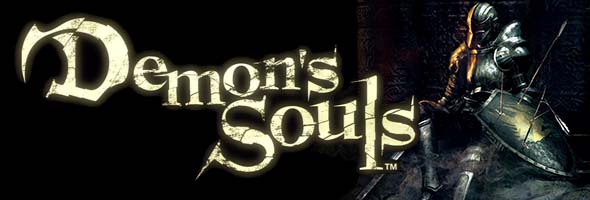
Rumors of a Demon's Souls remaster or remake have been floating around for a while now (as have rumors of a sequel). I have mixed feeling on the idea of a remake/remaster. On the one hand, Demon's Souls is one of my favorite games ever and may represent the peak of the series. Naturally, I want more people to play it and recognize its brilliance.
On the other hand, my fondness for the game means that I am hesitant to allow anyone to modify the game at all. After suffering through the abysmal Silent Hill HD Collection, I have strong reservations about any game remastering. Even the announced remake of Shadow of the Colossus has me on edge.
Matthewmatosis has posted an excellent retrospective look at how the subsequent
Souls games failed to live up to Demon's Souls' brilliance and originality.
Sadly, a remaster would probably mean that the servers for the original game would finally get shut down. But I guess having a replacement would be better than having no Demon's Souls at all...?
So with Dark Souls having come to its end with its Ringed City DLC, I've been thinking a lot lately about what I might want to see in any potential Demon's Souls remake or remaster -- if it were to happen.
Table of Contents
[More]
818fbc94-0834-4de0-9bd0-2664cf9988c8|1|5.0
Tags:Demon's Souls, From Software, Boletaria, remake, remaster, reboot, sequel, boss, soul, Old Monk, online, multiplayer, co-op, PvP, grass, Estus Flask, poise, item burden, equipment burden, crystal lizard

I was a little late at seeing the Bears' first 2017 preseason game. I had meant to record it Thursday evening and watch it later that night. Instead, my DVR recorded two hours of A Football Life instead of the game. I don't know if this was NFL Network's fault for airing the wrong show, or if it was Century Link's fault for mislabeling the schedule. In any case, I had to wait to record the re-broadcast later Saturday morning and watch it Saturday night.
I've been pretty vocal about my confusion with the Bear's offseason quarterback decisions. While I wasn't sorry to see Jay Cutler kicked to the curb, I was very unsure about signing Mike Glennon. I was even more dumbfounded by the Bears' decision to trade up to draft Trubisky after having already spent all that money on Glennon.
Glennon didn't give fans reason to be optimistic, as his preseason debut went about as bad as it could possibly go. His second pass of the game was intercepted by Chris Harris Jr. and returned for a touchdown.
Mike Glennon's second pass was intercepted by Chris Harris Jr. and returned for a TD.
In Glennon's defense, the offensive line wasn't doing him many favors. He seemed to be getting hit every time he dropped back. While Chris Harris Jr. was high-stepping the pick into the end zone, Glennon was peeling himself off the turf. If the Bears want Glennon (or any quarterback they decide to field) to be successful, then they're going to need to beef up their protection.
Cody Whitehair, in particular made a key mistake by snapping the ball over Glennon's head during the Bears' second possession. The ball was recovered by the Broncos, but the Bears' defense managed to hold them from scoring.

Cody Whitehair snapped the ball
over Glennon's head.
The Bears' third drive was where they were finally able to move the ball for the first time in the evening thanks mostly to their running game. Jordan Howard only got a few runs, but rookie Tarik Cohen made some pretty good runs that may earn him some extra play-time and maybe a spot on the final roster. Down 10-0, Glennon ended his night in the early second quarter with only two completions on eight attempts, with the pick-six and a quarterback rating of 0.0 -- yes, that's zero point zero!
Mark Sanchez didn't see much playing time, but I think the coaches probably have a pretty good idea of what Sanchez brings to the team... [More]
120d92ae-f1e3-413d-9132-8650f6b94a3e|0|.0
Tags:Chicago Bears, Chicago, Bears, NFL, NFL Network, football, Mike Glennon, Mitch Trubisky, Tarik Cohen, Adam Shaheen, Kadeem Carey, Victor Cruz, Rueben Randall, interception, preseason, rookie, Denver, Broncos, Denver Broncos, Century Link
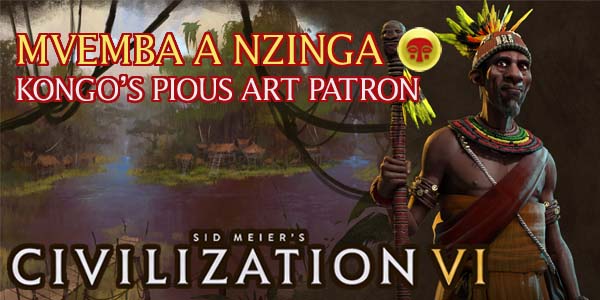
The Kingdom of Kongo was a small, but prosperous kingdom located on the west coast of sub-Saharan Africa. It can trace its origins back to the late 14th century, when Lukeni lua Nimi conquered the city of Mwene Kabunga and renamed it M'banza-Kongo. The city grew rapidly in an otherwise sparsely-populated region, and by the 17th century, it contained about one-fifth of the entire Kongo population (around 100,000 people). It's large population made it a prosperous and wealthy trading hub that eventually attracted the attention of European powers. The Portuguese set up colonies in Kongo territory, where they would set up a Roman Catholic church that would become one of the strongest churches in all of Africa. In 2017, the entire city of M'banza-Kongo was declared a UNESCO World Heritage Site.

In the first half of the 16th century, Kongo was ruled by Mvemba a Nzinga. His father converted to Christianity following the arrival of the Portuguese, and Mvemba a Nzinga added "Afonso" to his name, later becoming known as King Afonso I of Kongo. Afonso played a leading role in Kongo's conversion to Christianity and helped to establish and promote the Roman Catholic Church in the region. The reasoning for his conversion is unclear. Some scholars believe that he was motivated by genuine faith; while others believe that he was only complicit in the conversion in order to facilitate trade with European powers, and possibly to try to spare his population from becoming subject to the Atlantic slave trade. While Kongo had a slave economy of its own, and the kingdom willingly sold slaves to the Europeans, Afonso still denounced the Portuguese as exploiting Kongo's cooperation by kidnapping free Kongo citizens in violation of Kongolese law. The King of Portugal responded by dispatching officers to oversee the slave trade and ensure that only lawful slaves were sold to Europeans, and he demanded additional tribute from Kongo, such as wines and grains.
DISCLAIMER:
Civilization VI is still very early in its life-cycle. Strategies for the game (and for specific leaders and civs) may change as Firaxis applies balance patches, introduces new features, or expands the game through DLC or expansion packs, or as the Civ community discovers new strategies. As such, the following strategy guide may change from time to time. I will try to keep it up-to-date, and will make notations whenever changes are made. I'll also post links in the official 2K forums and CivFanatics, where I'll also report any changes made. If possible and practical, I will try to retain the original content of the strategy for posterity.
I welcome any feedback or suggestions that readers wish to offer. Feel free to post on the linked forums, or by posting a comment at the bottom of the page.
This guide is up to date as of the Summer 2017 patch (ver. 1.0.0.167) (Nubia DLC)
Kongo is a civilization that thrives in jungles and forest, growing massive (and productive) cities. Mvemba a Nzinga adds a unique religious flavor to the civilization by preventing it from being able to found its own religion, while simultaneously wanting other players to send their religion to you.
[More]
d42e1e83-3ee9-4f90-ab44-b8ddd956e2eb|1|5.0
Tags:Sid Meier's Civilization, Civilization VI, Kongo, Kongolese, Mvemba a Nzinga, Afonso I, Nkisi, religious convert, enthusiastic disciple, Ngao Mbeba, Mbanza, neighborhood, housing, appeal, religion, woods, rainforest, art, sculpture, archaeology, relic, artifact, museum, culture, slavery, Atlantic slave trade, unique improvement, unique melee unit, swordsman
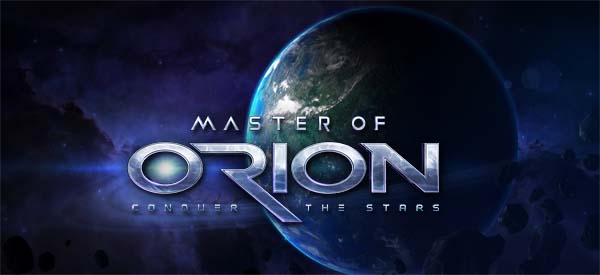
The 2016 reboot of Master of Orion kind of shoots itself in the foot a bit with its own subtitle: "Conquer the Stars". When I play 4x games, I like to feel like I'm really building an empire, managing an economy, and conducting diplomacy. All of those things are present in Master of Orion, but I've gotten a pretty distinct feeling that this is yet another strategy game that falls victim to military rushing being the optimal strategy by far. Master of Orion doesn't really want you to build a civilization and colonize the galaxy; it firmly wants you to do what its subtitle tells you: conquer the stars.
Master of Orion III was kind of shit (it was boring, ugly, and completely lacked personality and substance), but at least it made some effort to be new and interesting. Most noticeably, the galactic map was actually three-dimensional. Sure, this was a navigational and UI nightmare for the human player, but it required players to think differently about how they approached expansion and warfare. At a more fundamental level, MoO3 sought to be a game about macro-management, asking the player to manage a vast galactic empire rather than just a collection of a dozen or so planets. The meat of the game, thus, was intended to be in the mid-to-late stages, as developed empires engaged in epic battles for survival, rather than all the fun and challenge being front-loaded in the early rush to colonize all the nearby planets. It didn't work, but at least it was trying to genuinely innovate the 4x genre.
The new Master of Orion isn't anywhere near that ambitious, and seeks instead to simply bring the original Master of Orion concept (in its simplest form) into the age of high-resolution 3-d graphics. It's a scaled-down, bog-standard space-4x game that borrows heavily from Endless Space and Civilization V. But it is at least a competent one!
Conquer the Stars isn't as big, complex, or ambitious as Master of Orion 3, but at least it's competent.
The galaxy itself isn't very big this time around. Depending on the map's size, there's only a few dozen stars, and most of them only have two or three planets. Unstable star lanes and space monsters can lock you out of exploring certain systems until you research certain technologies or grow your military sufficiently large (respectively). Other than that, exploration is over fairly quickly (especially once you start performing map trades in diplomacy).
Planet-management is also fairly easy. You can assign population meeples between one of three different types of output: food, production, and research. Meeples of different jobs and races have different icons, and unhappy meeples on strike have icons that sit down holding a picket sign. It makes it very easy to see what your population's current status is at a glance. There's just not really much to do with them. You don't have to assign them to work specific buildings, and with only 3 outputs to manage, balancing or specializing isn't that difficult.
All the buildings in the game are also one-time builds that don't serve much function other than to provide flat points of one of the three outputs, or to modify the efficiency of meeples in a particular output category. Buildings that have unique functionality (such as the Spy Center, Gravity Generators, or Interplanetary Administration) are few and far between. The only other thing that you do with your planets is to occasionally terraform them in order to boost your max population and unlock additional slots along each of the output tracks.
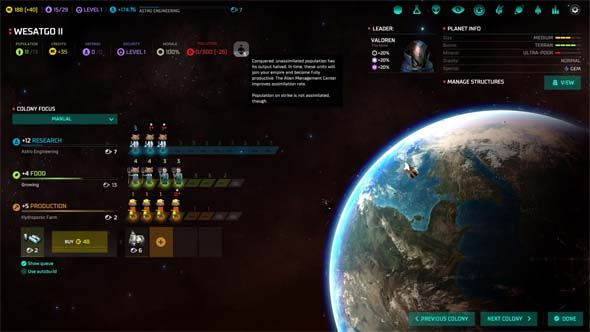
Each point of population is of a specific race, which affects the morale of conquered planets.
The tech tree also feels kind of bland and linear. I would much prefer a tech web along the lines of Civilization: Beyond Earth. Master of Orion kind of goes in this direction a bit by including some techs in which you have to chose which of two different items you want to take when you research certain techs. You can then trade for the other via diplomacy if you want to. It's kind of like the leaf nodes in Beyond Earth, but only some techs have them, and I rarely had to think too hard about which one I wanted... [More]
b529f082-d6e2-4759-8316-2633e3e77143|0|.0
Tags:Master of Orion, Master of Orion: Conquer the Stars, NGD Studios, Wargaming Labs, Steam, strategy, grand strategy, 4x, turn-based strategy, PC, science fiction, space, exploration, expansion, exploitation, extermination, colony, war, Michael Dorn, John de Lancie, Mark Hamill, Alan Tudyk, Nolan North, meeple, Master of Orion 3
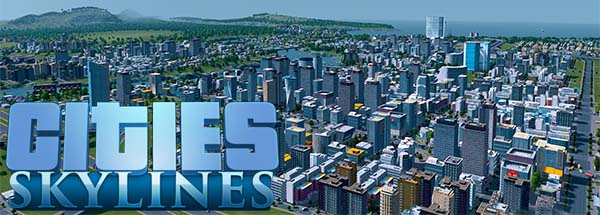
Some of the suggestions from my first wishlist have actually been implemented in Cities: Skylines. Naming roads, and adding directional traffic overlays were recently added in the Mass Transit expansion, and the previous Snowfall expansion incorporated some of my ideas for seasonal cycles (minus the part where the seasons actually cycle from one to another). There's still a lot of items from that wishlist that haven't been implemented. I also have come up with some new ideas for things I'd like to see in further expansions (or maybe a sequel?).
Taking the best ideas from its competitors
Even though Cities: Skylines is, by far, my favorite (and probably the objective best) city-building / city-simulation game of the past decade, there are still some features and ideas from the inferior games that I really like. In my first wishlist, I already talked about how much I liked the modular building mechanic of SimCity (2013).
I won't go into too much detail of why I liked that concept (even though the actual implementation was a little weak) because I invite you to read the original post. Suffice it to say, I liked the idea of certain pieces of city infrastructure (such as power plants, schools, universities, police stations, airports, government buildings, etc.) actually growing along with the city. Being able to upgrade an existing building to add additional functionality, additional capacity, or to specialize it in some way, was (in my opinion) a much more interesting and engaging process than simply plopping another copy of the same building every so often, or adjusting a global budget slider, simply to meet increasing demand.
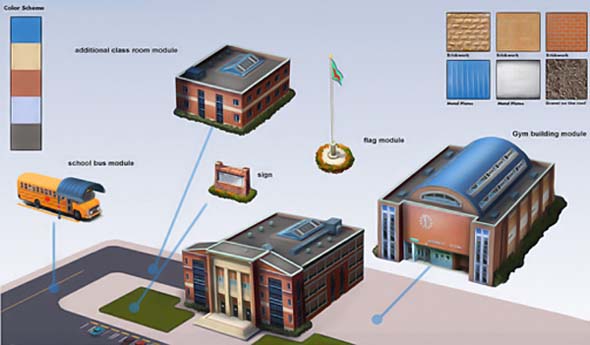
I still think SimCity had the right idea with its modular buildings.
In that first wishlist, I also briefly mentioned the Cities XL series. There isn't much in XL (or XXL) that is done as well (or better) than what is offered in either SimCity (2013) or Cities: Skylines, but I did neglect one idea that I think was probably the most clever, interesting, and fun part of the XL series of games: the ability to "fill" an area with "decoration". Put simply, Cities XL allows the player to fill any unoccupied area of the map (that is at least partially enclosed by roads) with one of several different types of decorative landscaping.
Landscaping options include a grassy park area with trees, an open-air "flea market" with kiosks and street vendors, various plazas / courtyards, and even a makeshift construction site. These decorations aren't functionally different (the flea market doesn't produce any commerce or jobs, for example), but each decorative area applies a very small environmental beautification effect that increases happiness and land value for adjacent homes or businesses.
Decorative areas in Cities XL allows you to fill-in irregular shapes with city-beautification projects.
From a more aesthetic standpoint, Cities XL's decorative areas allow the player to make very efficient use of space, to fill any empty dead space, and to create your own custom parks and plazas that conform to whatever shapes the outlining roads happen to be. Want a park in the middle of a large roundabout? Want a plaza space at the point of a 45-degree (or narrower) intersection? XL allows you to do such things without having to go into an asset-editor to make a custom ploppable.
Despite having muuuuuch better tools for creating curved and angled roads, Skylines doesn't really have any equivalent to these decorative features from XL that allow us to fill-in gaps left by our pretty, rounded or angled roads... [More]
61f9c85f-04f1-43df-ada3-cf727a4682d8|0|.0
Tags:Cities: Skylines, Cities: Skylines: After Dark, Cities: Skylines: Snowfall, Cities: Skylines: Natural Disasters, Cities: Skylines: Mass Transit, match day, Paradox Interactive, Colossal Order Ltd., PC, SimCity, CitiesXL, CitiesXXL, city simulation, park, decoration, parking, natural wonder, national park, beach, ski resort, tourism, leisure, history
|

| 12 | | | | | | | 60 | | 11 | | | | | | | 55 | | 10 | | | | | | | 50 | | 09 | | | | | | | 45 | | 08 | | | | | | | 40 | | 07 | | | | | | | 35 | | 06 | | | | | | | 30 | | 05 | | | | | | | 25 | | 04 | | | | | | | 20 | | 03 | | | | | | | 15 | | 02 | | | | | | | 10 | | 01 | | | | | | | 05 |
|